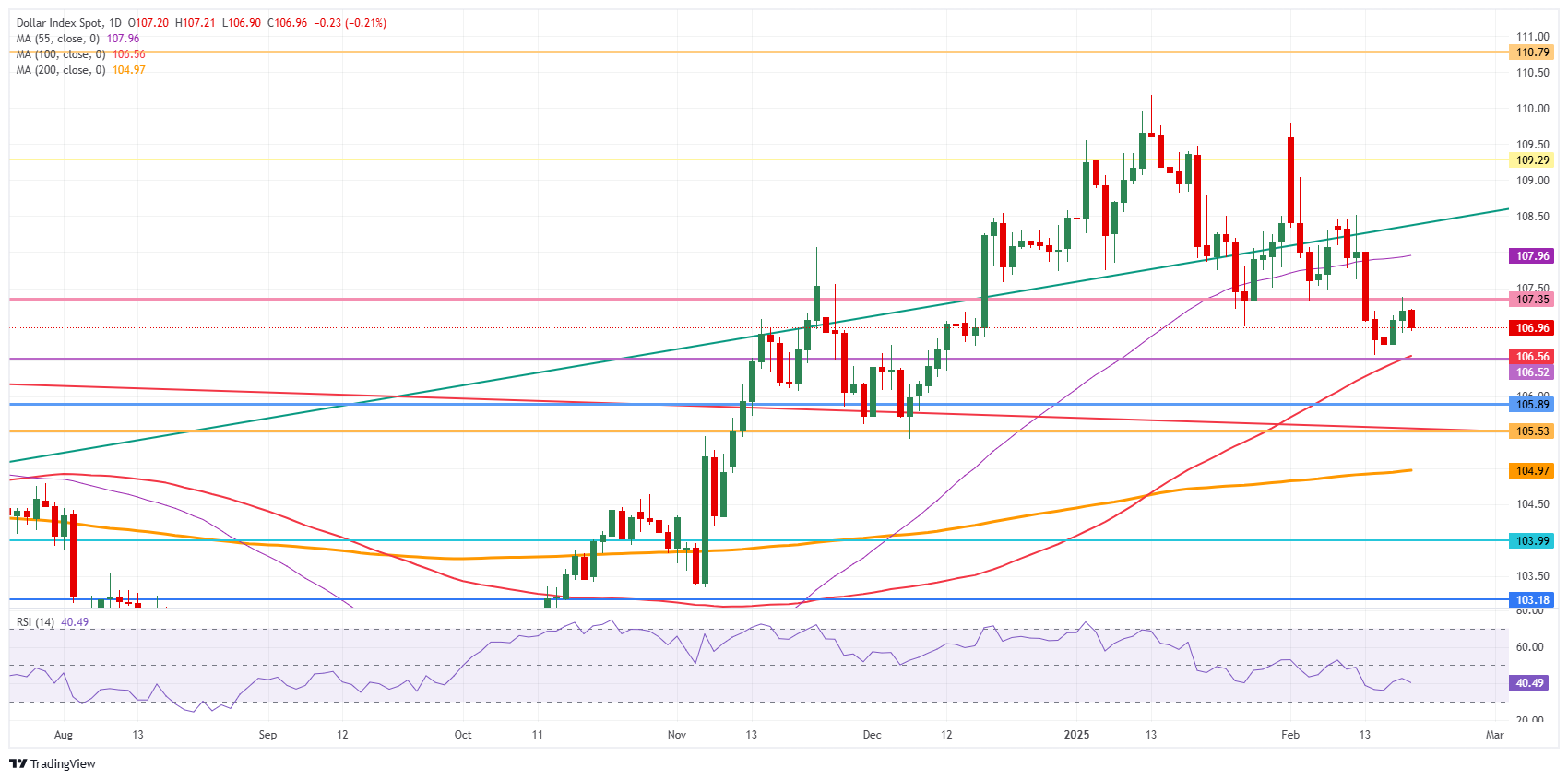US Dollar Index dips as the Greenback is unable to catch a break

- The US Dollar dips against major currencies on an otherwise calm Thursday.
- US President Donald Trump commented that a deal with China is a possible outcome.
- The US Dollar Index (DXY) erases Wednesday’s gains and dips below 107.00 after a firm upside rejection on Wednesday.
The US Dollar Index (DXY), which tracks the performance of the US Dollar (USD) against six major currencies, and is back below 106.90 at the time of writing. The correction comes after United States (US) President Donald Trump mentioned that a trade deal with China might come. This is a big sigh of relief in markets on the tariff and trade front, as it would mean that some easing could come before April when levies are due to kick in.
The US economic calendar is quite calm this Thursday, except for the weekly Initial Jobless Claims, the Philadelphia Fed Manufacturing Survey for February and some speeches by Fed policymakers. However, as it happened in the earlier part of this week, US data is likely to be overshadowed by Trump’s comments.
Daily digest market movers: US data could be another setback
- At 13:30 GMT, the weekly US Jobless Claims are due, with Initial Claims for the week ending February 14 expected to tick up to 215,000 from 213,000. Continuing Claims for the week ending February 7 are expected to head higher as well to 1.87 million, from the previous 1.85 million.
- At the same time, the Philadelphia Fed Manufacturing Survey for February is expected to decline to 20 from 44.3 in January.
- Quite an army of Fed speakers are scheduled for this Thursday:
- At 14:35 GMT, Chicago Fed President Austan Goolsbee speaks in a moderated Q&A at an event hosted by the Chicagoland Chamber of Commerce.
- At 17:05 GMT, St. Louis Fed President Alberto Musalem speaks to the Economic Club of New York about the US economy and monetary policy
- At 19:30 GMT, Fed Vice Chair for Supervision Michael Barr talks about supervision and regulation at an event at Georgetown University Law Center.
- Around 22:00 GMT, Federal Reserve Governor Adriana Kugler gives a speech on “Navigating inflation waves while riding on the Phillips curve” at a lecture hosted by Georgetown University.
- Equities are in red numbers across the globe, except for the European ones, with the German Dax and the pan-European Stoxx 50 in the green.
- The CME FedWatch tool shows a 51.2% chance that interest rates will remain unchanged at current levels in June.
- The US 10-year yield trades around 4.50%, slipping lower from its Wednesday’s high of 4.574%.
US Dollar Index Technical Analysis: Not catching a break
The US Dollar Index (DXY) is back to square one and gives up all its Wednesday’s gains. The firm technical rejection at 107.35 was enough to push the DXY back to where it was earlier this week. If US President Trump comes out with more easing or softening comments on tariffs or other deals, a revisit to 106.60 could be in the cards.
On the upside, the previous support at 107.35 has now turned into a firm resistance. Further up, the 55-day SMA at 107.96 must be regained before reclaiming 108.00.
On the downside, look for 106.56 (100-day SMA), 106.52 (April 16, 2024, high), or even 105.89 (resistance in June 2024) as support levels. The Relative Strength Index (RSI) momentum indicator in the daily chart shows room for more downside. Therefore, the 200-day SMA at 104.97 could be a possible outcome if a firm catalyst emerges.
US Dollar Index: Daily Chart
US-China Trade War FAQs
Generally speaking, a trade war is an economic conflict between two or more countries due to extreme protectionism on one end. It implies the creation of trade barriers, such as tariffs, which result in counter-barriers, escalating import costs, and hence the cost of living.
An economic conflict between the United States (US) and China began early in 2018, when President Donald Trump set trade barriers on China, claiming unfair commercial practices and intellectual property theft from the Asian giant. China took retaliatory action, imposing tariffs on multiple US goods, such as automobiles and soybeans. Tensions escalated until the two countries signed the US-China Phase One trade deal in January 2020. The agreement required structural reforms and other changes to China’s economic and trade regime and pretended to restore stability and trust between the two nations. However, the Coronavirus pandemic took the focus out of the conflict. Yet, it is worth mentioning that President Joe Biden, who took office after Trump, kept tariffs in place and even added some additional levies.
The return of Donald Trump to the White House as the 47th US President has sparked a fresh wave of tensions between the two countries. During the 2024 election campaign, Trump pledged to impose 60% tariffs on China once he returned to office, which he did on January 20, 2025. With Trump back, the US-China trade war is meant to resume where it was left, with tit-for-tat policies affecting the global economic landscape amid disruptions in global supply chains, resulting in a reduction in spending, particularly investment, and directly feeding into the Consumer Price Index inflation.
